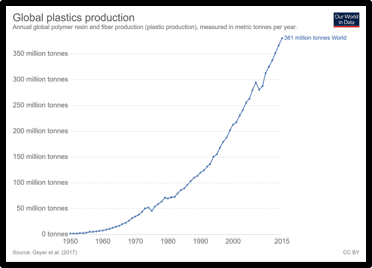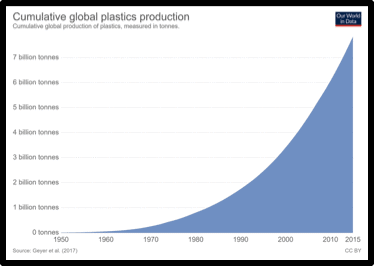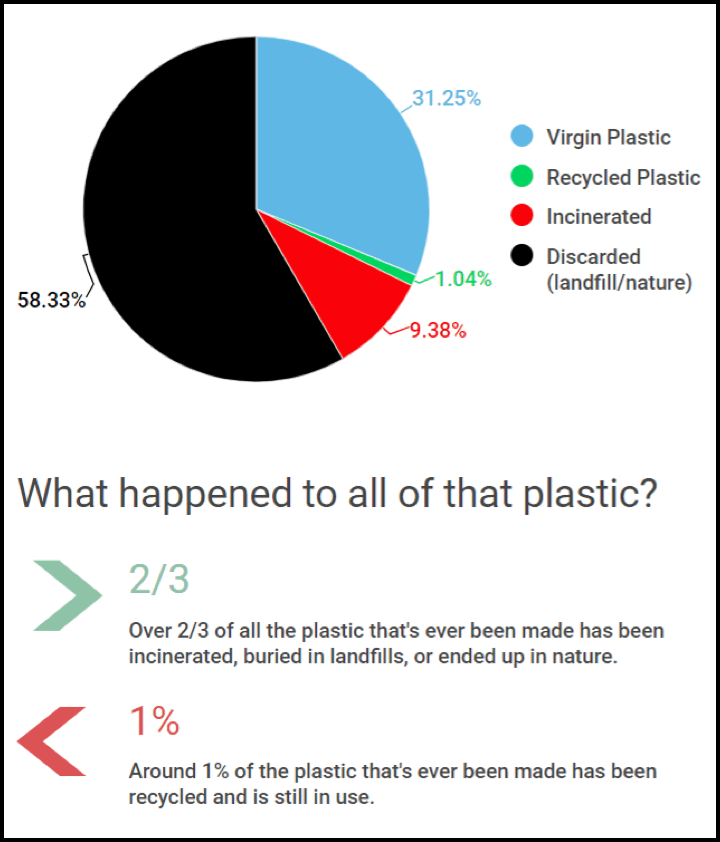4 min read
Plastic waste is a monumental challenge. I’m obsessed with the stuff, or rather, with helping humanity get it under control. Its many forms have brought great benefits to us for many years. But we haven’t figured out how to keep it from causing problems when we’re done using it. Recently, some have said that by mid-century there might even be more plastic than fish in the sea.
Plastics have become commonplace, but they have only been around for 150 years. For nearly a century, the materials slowly proliferated (In 1950, global production was around 2M tonnes), but over the last 50 years, it has grown exponentially (It’s now around 400M tonnes).[1]
Global Plastics Production (Annual and Cumulative)[2]
But while so much plastic has been produced, most of it has never been recycled. And most of the plastic that has been recycled eventually ends up being incinerated or discarded in landfills.
The State of Plastic[3]
Worse yet, a recent study estimated that we would produce four times as much waste plastic between 2015 and 2050 than we had in the prior 146 years.[4]
Are your alarm bells going off yet? (I hope they are.)
Rethinking Plastic Use
Given these circumstances, we have to look for ways to make a difference, no matter how small. You can start by reviewing the ways in which you use plastic. Doing so can be really eye-opening.
Try this exercise. Think through your typical day and focus on the single-use plastics you engage with. Did you use soap, shampoo, toothpaste, or other toiletries that were stored in plastic containers? Did those items come wrapped in plastic or were they transported in plastic bags that were later discarded? What plastics were involved in your commute and meals, as well as in your work day and leisure? Try to stay mindful of this exercise throughout the day.
At the end of the day, go through the list you’ve compiled and think about what’s necessary versus what’s optional? This is a subjective process, but it’s useful to think through how important these things are to our survival, happiness, and well-being. Once we’ve done that, we can start thinking about substitutions we might make, as well as whether there are things we could eliminate. In doing so, we should probably consider the survival, happiness, and wellbeing of others, including future generations.
We can also look beyond our personal lives for opportunities at home, through our work, and in our communities. Those macro changes are the kinds I focus on in my work. I previously ran zero waste programs in the US grocery industry, where we aimed to reduce our waste to landfill by 90%. This meant finding ways to create less waste and beneficial things to do with any that remained.
The most important thing I learned from that work is to change how I think about waste. We shouldn’t view waste as a natural output of our lives, but rather as an unnatural outcome of our collective choices.
This is a crucial step for anyone trying to move towards a circular economy.
I hope this point is clear. We choose to live the way we do because it’s cheap and easy, at least in the short-term. But the long-term bill is coming due — and if we don’t pay it down soon, we’ll wish we had.
Building the New Things
Of the resources in our daily lives, many were not designed for things like reuse, repair, or recycling. My startup, Full Circle Filament, is trying to help. We’re bringing a high-quality, recycled 3D printing filament to market. In doing so, we’re working with informal waste pickers to help increase their incomes, by paying above market rates for the materials they collect. The goal is to improve their lives while increasing recycling rates. And we’re aiming to prove a model that can be replicated wherever similar conditions exist, while helping others reframe their mindsets to see waste materials as an immense opportunity.
I’m also involved with the Circular Design Lab, an effort that’s developing a design framework that’s integrated with systems thinking. The goal is to create a participatory design process that will enable communities and organizations to carefully re-envision the systems they interact with to foster more desirable outcomes. (You can track our steps via The RSA blog)
These efforts do very different things, but their goal is the same — to help cities begin to function like ecosystems, cycling resources rather than expending them.
We spent the last six months engaged in ImpacTech’s latest Thailand cohort, which gave us the opportunity to refine our strategy and get ready to go to market. We’re proud to share that our team took first in the Demo Day and we’re now working with our partners at Covestro to develop enough filament for thorough product testing as we complete our market research.
For now, we’re focused on fundraising. The pieces are getting lined up, and we’re currently seeking early-stage investors, while we’re also pursuing a number of grant opportunities, and courting CSR funds.
If our project is of interest, check out our Deal Share page and don’t hesitate to reach out if you have any questions. We’re always happy to have the chance to tell our story!
[1] “The History and Future of Plastics: What Are Plastics, and Where Do They Come From?” Science History Institute, 2019, https://www.sciencehistory.org/the-history-and-future-of-plastics.
[2] Hannah Ritchie and Max Roser, “Plastic Pollution,” Our World in Data, September 2018, https://ourworldindata.org/plastic-pollution.
[3] Giorgia Guglielmi, “In the next 30 years, we’ll make four times more plastic waste than we ever have,” Science, July 19, 2017, https://www.sciencemag.org/news/2017/07/next-30-years-we-ll-make-four-times-more-plastic-waste-we-ever-have.
[4] Ibid.





















